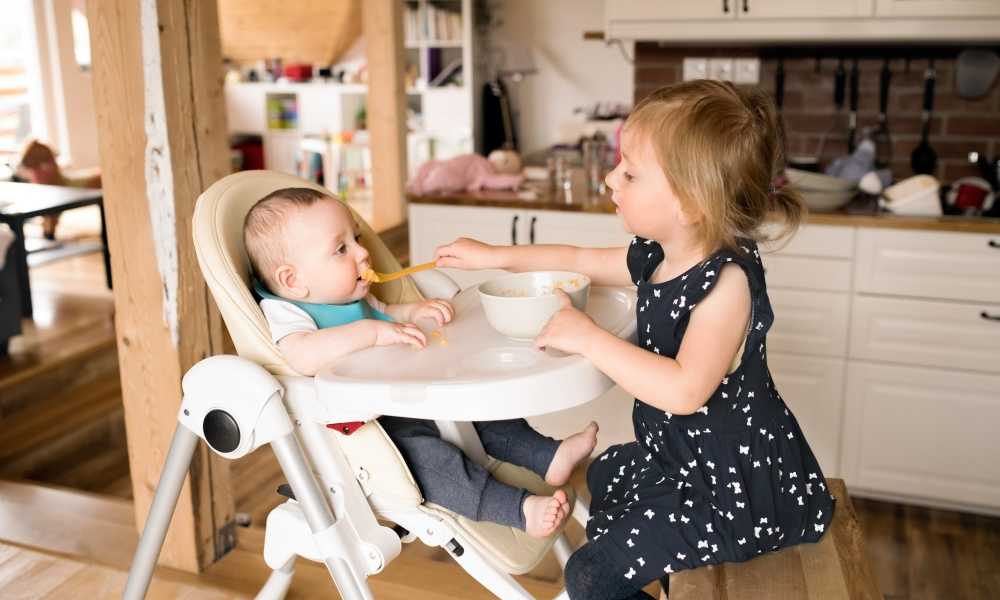Fallout of a baby meal in a high chair can prove stupefying. You may wonder how baby managed to get anything into their mouth because once you remove the baby from the chair, brush them off, and remove their bib, you are left with a plethora of bits and pieces of food in, on and around the chair.
Milk drips from the food tray, and toys are encrusted in yuck. You know what I mean. Been there, done that. Got the T-shirt.
In years past, this would have been a task of monumental proportions, requiring hours of cleanup time. Today’s chairs, however, are so much easier to clean. Food trays are dishwasher safe. Chair pads are machine washable, and you can wipe the frame to a gleaming shine with a damp cloth.
When it comes to baby, we want to be reasonably sure we’ve killed off as many germs as possible. Let me share a few tips to free your high chair from the “baby goo.”
Most manufacturers claim you can clean their product with a moist cloth. That works in the short term and for what we can see with the naked eye, but bacteria very easily hide from the naked eye. Just leave behind a little crumb, a spot of dried drink, and you have a great home for a variety of nasty germs.
In truth, just wiping it down may work well in a pinch, but for a really clean chair you need to follow some common sense tips. This little cleaning regimen will help you avoid a buildup of food and keep your baby’s high chair safe and clean.
Begin with a regular routine after each meal. Brush away all the loose food particles and wipe down the eating area with a damp rag or preferably a cleaning solution. Wipe with a dry cloth then allow to air dry.

Sanitize the food tray
This is very important because it comes in the closest contact with your baby’s food. You have a few methods available to you. Wash it in the sink with hot, soapy water. Dry it as well as you can, then let it air dry.
If you’re running your dishwasher and your food tray is dishwasher safe, by all means add it to the machine. You can also sanitize it by using a disinfectant spray, diluted bleach solution or white vinegar.
Once a week sanitize the chair seat
If you have a seat that attaches to a regular chair, remove it and clean underneath making sure to wipe away all food particles and then disinfect that area. Put the seat back on and remove the chair pad. Sanitize the seat and wash the chair pad according to the manufacturer’s instructions.
Some are machine washable; others only hand washable in the sink. Refer to your instruction manual for the best method for your seat. In any case, make sure you get it clean.
Once a month, take all the pieces of the high chair apart and wash them separately
That is, remove the seat, the cushion, the straps, and tray. Make sure you clean them all. Some are totally machine washable so this is a snap. But follow manufacturer’s instructions.
If you have to hand wash the baby high chair, wash them with hot soapy water in the sink or use a sanitizing spray. Dry as well as you can, then let air dry.

Remove all food and drink residue from all the little crevices and channels in the plastic
Scrub off any food that may have stuck on. Get rid of any dried-on drink residue. Then spray with disinfectant and let dry. When everything is clean and dry, reassemble the chair. It’s ready for another month of use.
This is a regular cleaning routine that will not take you hours and hours, but a few minutes each day, about 15 minutes once a week, and about 30 minutes once a month. The great advantage to following this schedule is that it will not allow food to build up and it will keep the germs to a minimum.
Imagine yourself sitting at a table to eat a meal that is encrusted with old food, dried coffee and all manner of dried food scattered about. None of us would find that very appetizing. I think I’d make some kind of polite excuse and walk away for fear I might come into contact with some kind of deadly microbe.
Your baby doesn’t know any better yet, so you have to protect them from such dangers. In the world we live in, these dangers are very real, particularly when we have resistant strains of previously easily curable bacteria.
FINAL VERDICT
The odds are these germs don’t exist in your home. And we can’t go through life looking for monsters behind every little tree, but we can take precautions, and we should, especially where our children are concerned.

